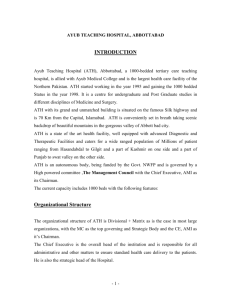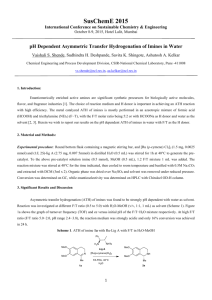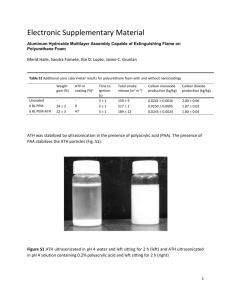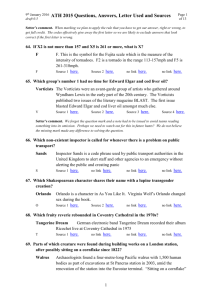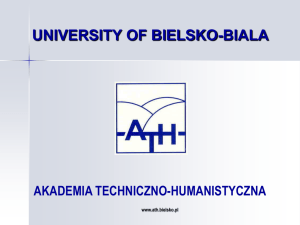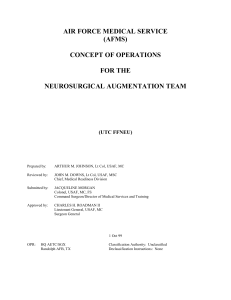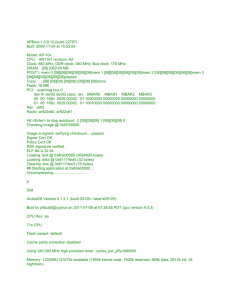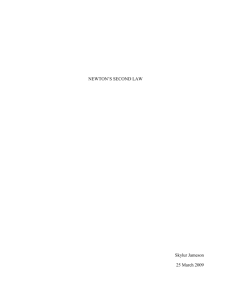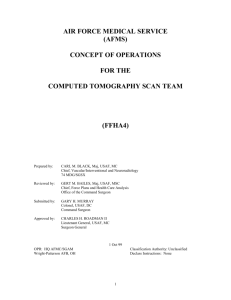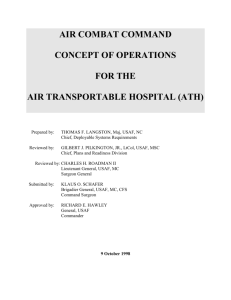ffrad - The Brookside Associates
advertisement
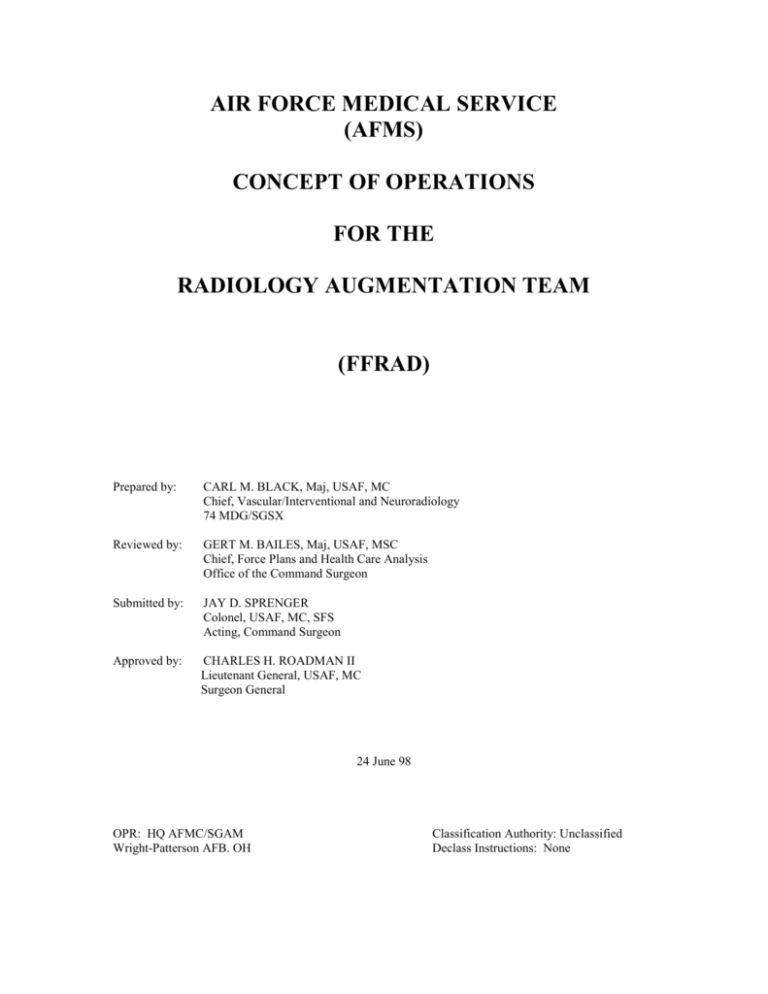
AIR FORCE MEDICAL SERVICE (AFMS) CONCEPT OF OPERATIONS FOR THE RADIOLOGY AUGMENTATION TEAM (FFRAD) Prepared by: CARL M. BLACK, Maj, USAF, MC Chief, Vascular/Interventional and Neuroradiology 74 MDG/SGSX Reviewed by: GERT M. BAILES, Maj, USAF, MSC Chief, Force Plans and Health Care Analysis Office of the Command Surgeon Submitted by: JAY D. SPRENGER Colonel, USAF, MC, SFS Acting, Command Surgeon Approved by: CHARLES H. ROADMAN II Lieutenant General, USAF, MC Surgeon General 24 June 98 OPR: HQ AFMC/SGAM Wright-Patterson AFB. OH Classification Authority: Unclassified Declass Instructions: None TABLE OF CONTENTS SUBJECT PAGE EXECUTIVE SUMMARY 4 SECTION 1 - GENERAL 1.1. Purpose: 1.2. Background: 1.3. Threat: 6 6 6 6 SECTION 2 - DESCRIPTION 2.1. Mission/Tasks: 2.2. FFRAD Capabilities/Team and Equipment Description: 6 6 6 SECTION 3 - OPERATIONS 3.1. Employment: 3.2. Deployment/Redeployment: 8 8 8 SECTION 4 -COMMAND & CONTROL RELATIONSHIPS STRUCTURE 9 SECTION 5-INTELLIGENCE/NATIONAL AGENCY/SPACE SUPPORT 9 SECTION 6-COMMUNICATIONS/COMPUTER SYSTEM SUPPORT 9 SECTION 7-INTEGRATION & INTEROPERABILITY 7.1. Integration With Other Systems/Teams: 7.2. Interoperability: 9 9 9 SECTION 8 - SECURITY 8.1. Operations: 8.2. Physical: 8.3. Controlled Substances 10 10 10 10 SECTION 9 - TRAINING 9.1. USAF and/or MAJCOM Directives 9.2. Annual ATH/AFTH Training 9.3. Mission-specific CMRT 10 10 10 10 SECTION 10 - LOGISTICS 10.1. Tables of Allowance 10.2. Logistic Support 10.3. Medical Equipment Maintenance 10 10 10 10 SECTION 11 - SUMMARY 10 2 GLOSSARY OF TERMS 11 3 EXECUTIVE SUMMARY I. GENERAL. This document provides the Concept of Operations (CONOPS) for the Radiology Augmentation Team (FFRAD), a supplemental asset of the Air Force Air Transportable Hospital (ATH) or Air Force Theater Hospital (AFTH). It describes the use, employment, deployment, and redeployment of the FFRAD as a component of the ATH/AFTH medical system. It focuses on pertinent aspects of capabilities, employment, and interoperability and is not intended to provide minute detail of all aspects of operations. The FFRAD will be deployed with an ATH/AFTH to boost its capability to a 3rd to 4th echelon level of care to meet specific medical requirements related to a mission. It is not a stand alone asset, and requires support provided by the ATH/AFTH. II. DESCRIPTION. The main mission of the FFRAD is to provide on-site, advanced diagnostic imaging and percutaneous, minimally invasive interventional services to patients during wartime operations, humanitarian operations and Small Scale Contingency Operations (SSCO). It may also be used to augment the general imaging and interventional needs of trauma related casualties. FFRAD will also have the capability of providing 24 hour a day teleradiology consultation to smaller ATH facilities. No provision has been made for ultrasound (US) capability. If US equipment is added, it should be capable of full integration into the teleradiology system (DICOM compatible) to allow for off-site consultation and digital image transfer. FFRAD manpower is: FAC AFSC 5202 5202 5202 44R3B Diagnostic Radiologist 4R071 Diagnostic Imag Cfmn 4A251 Biomed Eqp Jnmn Strength: AFSC Title Officer 1 SEI 479 Airmen 2 GRADE QTY O-4 1 1 1 Total 3 This staffing can provide 12 hour per-day coverage, six days per week. The Biomedical Equipment Journeyman and the Diagnostic Image Craftsman should have equipment-specific training. No provisions have been made for nursing coverage, which would then have to be provided by the ATH/AFTH. III. OPERATIONS. Once delivered on site, the FFRAD staff and a limited number of base support staff can set up the equipment, including the isoshelter, and be operational within 24 hours. At a minimum, the following base support staff are needed during this set up period: forklift operator (with lift capacity of 13,000 lbs.), electrical/ground power equipment specialists, communications specialists, fuel and potable water delivery specialists, and sanitary waste system specialist. There will be a requirement for on-going equipment support as well from the ATH/AFTH. IV. COMMAND AND CONTROL RELATIONSHIPS STRUCTURE. The team chief, a staff radiologist, will oversee the operation of the team. He or she will be under the command of the Director of Base Medical Services or the MTF commander. V. INTELLIGENCE/NATIONAL AGENCY/SPACE SUPPORT. The FFRAD will rely on the ATH/AFTH for support. VI. COMMUNICATIONS/COMPUTER SYSTEMS SUPPORT. The ATH/AFTH will provide a baseline AF communication system. Defense Switched Network (DSN) and other communications capabilities may be required as part of local base operating support (BOS). Computer support will be required for information processing. Teleradiology capability is anticipated which will allow long-distance consultation between radiologists and providers stationed at smaller, distant ATH’s. The FFRAD 4 will help with central radiologic consultation. DICOM compatibility is highly recommended to facilitate digital image transfer. Angio/fluoro and CT (US if implemented in the ATH) should be digitally interfaced into a single workstation (DICOM compatible) if possible. This interface will enhance capability of digital image transfer capability and local image archiving. VII. INTEGRATION & INTEROPERABILITY. Integration of deployed assets into a theater is critical for successful operations. BOS is required for messing and other consumables, to include: water, fuels, billeting, latrines, showers, laundry, waste management, non-medical transportation, non-medical maintenance and logistics, and security to sustain the medical mission of the FFRAD. FFRAD will integrate with ancillary radiological services with complete ability to cross-cover. IX. SECURITY. Although the medical community represents a passive asset, security for patients and personnel resources within the immediate area of the FFRAD is necessary. The host unit/wing will be required to provide security. Medical personnel may be armed, as dictated by the current threat environment, the mission profile, and in accordance with Geneva Conventions guidelines. While the ATH/AFTH and FFRAD may provide their own site security measures within their immediate area as deemed necessary, the medics depend heavily on base security forces for major defense sustainment. A limited quantity of controlled substances (Versed and Fentanyl) will be stored in the Angio/Fluoro isoshelter in a locked cabinet. This will be subject to daily accounting through pharmacy. X. TRAINING. Training, specific to the ATH/AFTH will cover deployed imaging and interventional operations pertinent to war-related and in some cases community illnesses and all phases of deployment/employment/redeployment. Readiness training will be conducted according to USAF and MAJCOM directives. Training may also be conducted in conjunction with command sponsored or local training exercises, or in conjunction with operational deployments. Joint training is encouraged to foster relationships and enhances the capabilities of each service. Personnel assigned to mobility positions for the FFRAD should be familiar with the operation of the ATH/AFTH. Routinely scheduled FFRAD training should occur locally at the facility responsible for its inventory, personnel and deployment readiness. CMRT should be focused on training staff radiologists and technologists in the set-up and operation of the Radiology Augmentation module. The isoshelter module should be inventoried periodically for content and tested with actual patient procedures if possible. The FFRAD is in a somewhat unique position, in that it can conduct realistic exercises apart from the ATH as a separate unit. The importance of local inventory, equipment assessment and training cannot be overstated. Equipment-specific training will be required for biomedical engineering technologists (BMET) deployed with FFRAD. Specialized training should be coordinated by contract with the equipment vendors. XI. LOGISTICS. The FFRAD will deploy with sufficient supplies to be self-sufficient for 30 days when deployed as a supplement to the ATH/AFTH. Supply estimates are based on a casualty model that generates high casualties for five days, followed by a sustained action component until resupply can be established. Approximately five patients per day are anticipated through Angio/Fluoro. When the Single Integrated Logistics Manager (SIMLM) is established, resupply will be coordinated accordingly. Service components are responsible for establishing a theater logistics and supply account system. Vehicles and their maintenance will be acquired through local host or closest base with this capability. Base operating support (BOS) will be required at every location where an ATH/AFTH and Radiology Module is established. XII. SUMMARY. The Radiology Augmentation Team (FFRAD) will fall under the direct supervision of a staff radiologist to support an enhanced ATH or AFTH. It can deploy worldwide to support various operations at a level of 3rd to 4th echelon care. 5 SECTION 1 - GENERAL 1.1. Purpose: This document provides the concept of operations for FFRAD resources. It describes command relationships, assigns tasks, and furnishes generic guidance for the development of a FFRAD assigned to an ATH/AFTH in support of operations envisioned in the Regional Operational Plans (OPLANs), exercises in which medical forces participate, and contingency/humanitarian operations. This document is also developed to provide guidelines for: (a) identifying and defining FFRAD responsibilities; (b) defining the interrelationship between the ATH/AFTH and FFRAD; (c) ensuring adequate resources are available to support global operations associated with regional plans; (d) providing a source document for developing FFRAD policies, standard operating procedures, and training programs; (e) and validating future FFRAD requirements and revisions to planning and training concepts. 1.2. Background: The ATH has been the main deployable medical asset to support a variety of military missions, with an emphasis on treating injuries and illnesses associated with war. In recent years the USAF has become involved in an increasing number of SSCO scenarios. These experiences have revealed that the standard ATH does not provide adequate medical and surgical support for the populations that have been encountered in these SCCOs. Various modular units representing multiple specialties are being developed to respond to this need. 1.3. Threat: The USAF responds globally to a broad range of situations requiring medical care. The medical threats involved can be categorized into several types. 1.3.1. Disease Non-Battle Injury (DNBI): This threat is variable, depending on geographical location, and is determined by endemic disease, climate, and socioeconomic conditions. Preventive medicine teams, theater epidemiology teams, proper waste management, consultation with specialists, availability of advanced treatment modalities and diagnostics, and medical information management systems are required to minimize this threat. This type of threat will make up the majority of casualties. 1.3.2. Conventional and Exotic/Unconventional Weapons: These weapons carry the potential to inflict personal injury in the form of trauma. Civilians may sustain the same injuries as active duty forces when they are in close proximity to the active fighting and when civilian areas are targeted. Effectiveness of traumatic injury therapy is related to advanced diagnostic capability, use of equipment and techniques representative of the current standard of care, specialty consultation, medical information access, communication and air evacuation, and ability to process tests and data rapidly. 1.3.3. Weapons of Mass Destruction (WMD): These weapons include nuclear, biological, and chemical weapons. SECTION 2 - DESCRIPTION 2.1. Mission/Tasks: The primary mission of the FFRAD is to support active duty forces in wartime. Included in this is the diagnosis and treatment of acute illnesses and injury. The secondary mission of the FFRAD is providing imaging and minimally invasive therapeutic support to forces and populations involved in humanitarian and other SSCOs. It can respond to mass casualties by providing specialized and unique diagnostic imaging and interventional support. 2.2. Capabilities and Equipment Description: The FFRAD has the ability to rapidly deploy in conjunction with an ATH/AFTH to provide diagnostic imaging and interventional support to Air Force operations worldwide during contingencies. The FFRAD is designed to support a population of 5000-60000 personnel at risk for 30 days without resupply. This is based on the assumption only essential care will be provided, and that patients will be evacuated to higher echelons of care for definitive therapy. The FFRAD will deploy with an enhanced, specialized ATH/AFTH of at least 50 beds. The Table of Allowance (TA) is based on this assumption. On average Radiology Augmentation Team can accommodate at least 5 patients/day. 6 2.2.1. The capabilities of the FFRAD will be comparable to those found in a tertiary medical center. Advanced imaging and interventional services provided will include: 2.2.1.1. Angiography provides functional arterial/venous evaluation. The C-arm should have digital subtraction, road mapping and last image hold capability. Fluoroscopy will allow GI tract evaluation in addition to other nonspecific applications. 2.2.12. Minimally invasive, percutaneous non-vascular intervention. Capability includes nephrostomy/ureteral stent placement, biliary decompression, abscess drainage, and percutaneous gastrostomy. 2.2.1.3. Minimally invasive, endovascular procedures including arterial embolization in acute, posttraumatic hemorrhage; temporizing arterial balloon occlusion pending definitive surgical intervention; intravascular foreign-body retrieval; IVC filter placement and central venous line placement. 2.2.2. The Angio/Fluoro isoshelter will also require a dedicated power injector, procedure table, and patient monitoring equipment. A stand-alone Imation (Plus) dry film processor is recommended. 2.2.3. In an acute trauma setting, medical history is not always reliable or attainable. In order to prevent potentially life-threatening contrast reactions from iodinated intravascular contrast, all intravascular contrast agents should be non-ionic. This recommendation pertains to IVP (including intraoperative), venography and angiography. 2.2.4. Teleradiology: Digital teleradiology capability will be part of the enhanced 50 to 90 bed ATH/AFTH. Radiologists will be available 24 hours a day, 7 days a week to interpret images transmitted from distant, smaller ATH’s. The teleradiology equipment includes a PC, monitor and a digitizer for plain film. The angio/fluoro, CT and US units should be DICOM compatible, which allows a direct digital link into the teleradiology system. 2.2.5. Personnel/Manpower Requirements: The FFRAD will be staffed with the following personnel: FAC AFSC 5202 5202 5202 44R3B Diagnostic Radiologist 4R071 Diagnostic Imag Cfmn 4A251 Biomed Eqp Jnmn Strength: AFSC Title Officer 1 SEI GRADE QTY O-4 1 1 1 479 Airmen 2 Total 3 The assigned manpower is sufficient to operate 12 hours per day, 6 days per week (including teleradiology support) with allowance for illness or periodic rest. Physicians will be Advanced Cardiac Life Support (ACLS) qualified. Radiology technicians should be Emergency Medical Technician qualified, although this is not mandatory. Radiology technicians will be skills verified. The staffing may be adjusted to fit the needs of the specific mission. Biomedical Equipment personnel assigned to FFRAD should have specialized and manufacturer-specific training in repair and maintenance. This level of training should be coordinated with the individual equipment vendors at the time of purchase. SECTION 3 - OPERATIONS 3.1. Employment. 3.1.1. General: The FFRAD is designed to deploy with a 90-bed, enhanced ATH/AFTH. The ATH/AFTH will provide inpatient facilities, pharmacy, laboratory, and basic radiology support. It will deploy with supplies necessary to support a population of 5000-60000 patients for 30 days. Resupply will occur through ATH/AFTH resupply channels. The FFRAD can work with the Aeromedical Evacuation System for enhanced patient support until the patient is evacuated. 7 3.1.2. Deployment locations: The FFRAD is designed for global deployment in support of a variety of operations. 3.1.3. The FFRAD can expect to be utilized for a wide variety of patients, including some dependents of U.S. citizens and the local population. 3.1.4. Patients will be treated and stabilized within the limitations of the ATH/AFTH. Critical care support, other than the initial stabilization, may not be possible. In mass casualty situations, patients will be treated in accordance with ATH/AFTH protocols. 3.1.5. During SSCOs, patients will be brought to the FFRAD via POVs, military vehicles, or under their own power. 3.1.6. Patients may require evacuation from the ATH/AFTH. This normally occurs within two to fifteen days as determined by the theater evacuation policy. 3.1.7. Radiographs will be stored and filed for review throughout a patient’s ATH/AFTH admission. Hard copy can be digitized for teleradiology transmission to the next facility accepting the patient in transfer. The hard copies may also accompany the patient with pertinent radiologist interpretations. 3.1.8. Appropriate documentation of medical care will be accomplished on all patients examined and treated by the FFRAD. The use of Standard Form (SF) 600 and SF 558 will generally suffice. Appropriate documentation of the number of patients and their specific diagnoses will be maintained. For patients being evacuated, the DD Form 602 should accompany the patient to ensure proper documentation of care during transport. 3.1.9. During SSCOs, the appropriate course of treatment must be considered with respect to the local standard of care, local customs, and expectations of the local population. Consideration must be given to the fact that medical practices in the United States differ greatly from many areas to which the FFRAD can deploy. Awareness of this difference may influence the initiation or discontinuation of treatment and evacuation. 3.2. Deployment/redeployment will be conducted according to ATH/AFTH protocols. SECTION 4 - COMMAND AND CONTROL RELATIONSHIP STRUCTURE 4.1. The FFRAD will be under the leadership the team chief, a staff radiologist. The team chief will report to the Director of Base Medical Services or the ATH/AFTH commander. The commander will determine how deployed ancillary teams will functionally report within the facility. SECTION 5 - INTELLIGENCE/NATIONAL AGENCY/SPACE SUPPORT 5.1. The FFRAD will rely on the ATH/AFTH for this support. SECTION 6 - COMMUNICATIONS/COMPUTER SYSTEM SUPPORT 6.1. Computer systems to provide word processing, data base management, graphics, and local area network/wide area network (LAN/WAN) interface capability will be required. The system will require the capacity for report management and archiving. CD-ROM capability is desirable for access to Air Force publications and medical references. 6.2. The FFRAD communication needs will be supplied by the host organization, similar to the needs of the ATH/AFTH. A land line is also desirable for information exchange. Medical or casualty information can become an operations security (OPSEC) issue when linked to a particular military mission or operation. While medical information itself is not classified, in the context of a mission, it can be protected as part of the CINC's overall OPSEC program to deny information to the enemy. 6.3. CHCS should be configured to meet order entry and reporting needs. An alternate means utilizing hard copy will be utilized if an electronic capability is not available. 8 SECTION 7 - INTEGRATION AND INTEROPERABILITY 7.1. Integration with other systems/teams: 7.1.1 Ancillary Team: FFRAD will combine efforts with the radiologic facilities deployed with the ancillary team. There will be technologist cross-coverage. The staff radiologists will supervise and will be responsible for timely examination interpretation. 7.1.2. ATH/AFTH integration: The FFRAD will deploy with an initial 30 day supply of medications and supplies, but for a sustained deployment will rely on resupply through the ATH/AFTH logistics system. Laboratory, radiographic and pharmaceutical (medication storage, dispensing, and labeling ) support will be required. 7.1.3. The FFRAD table of allowance provides for biohazard and sharp specimen collection. Disposal will be required through the ATH/AFTH. 7.1.4. Host base integration: The FFRAD will rely on the host base for BOS, similar to the needs of the ATH/AFTH. 7.2. Interoperability: This function will be handled according to ATH/AFTH guidelines. Coordination with local medical authorities may be required in order to evaluate and treat local citizens. This will require approval of the ATH/AFTH commander. SECTION 8 - SECURITY 8.1. Operations: The FFRAD will generally not be dealing with classified military information. However, patient confidentiality must be maintained as much as possible in a field environment. This will include appropriate storage of radiographic storage, medical records, release of medical information on a "need to know" basis, minimizing transmission of patient information over LMRs, and appropriate control of access to computerized information (e.g., use of passwords). 8.2. Physical: As the FFRAD is integrated into the ATH/AFTH, security needs are comparable. 8.3. Controlled Substances: Limited quantities of controlled substances (Versed and Fentanyl) will be maintained in the Angio/Fluoro isoshelter in a locked cabinet per pharmacy protocol. SECTION 9 - TRAINING 9.1. Readiness training will be conducted IAW USAF and/or MAJCOM directives, and should occur in conjunction with ATH/AFTH training. 9.2. Joint annual training between the ATH/AFTH and other specialty modules would be optimal in order to maximize the integration of these interrelated functions. 9.3. Mission-specific CMRT should occur at the local level of the base responsible for the FFRAD. Training exercises should include inventory, equipment-specific training and actual patient procedures when possible. This measure will help assure that the FFRAD is mission capable and ready for integration into the ATH/AFTH. SECTION 10 - LOGISTICS 10.1. Medical supplies and equipment required to operate the FFRAD are listed in the Table of Allowance. 10.2. Logistic support will be required on site, especially during the deployment and redeployment phases. This will include logistic personnel and forklift capability (13,000 lb. capacity). 9 10.3. Medical equipment maintenance and repair will be carried out by biomedical equipment technicians who deploy with the team. The FFRAD is technologically complex, and requires technical personnel with modality-specific training. This type of training should be obtained through the manufacturer as necessary. SECTION 11 - SUMMARY The Radiology Augmentation Team is a military medical asset designed for worldwide deployment to support various medical contingencies. It deploys with a 3rd or 4th echelon ATH/AFTH (50 bed or more augmented configuration) and is capable of supporting all surgical and medical specialties with state-of the art diagnostic imaging and emergent intervention. Its development drastically enhances the ability of the USAF to deliver exceptional care to patients during wartime scenarios and SSCOs. 10 GLOSSARY OF TERMS Abbreviations Definitions ACLS Advanced Cardiac Life Support Angio/Fluoro Angiography and Fluoroscopy ATH Air Transportable Hospital BMET Biomedical Equipment Technician CONOPS Concept of Operations DSA Digital Subtraction Angiography US Ultrasound CT Computed tomography FFRAD Radiology Augmentation Team (Angio/Fluoro) Philips potential C-arm vendor MOOTW Military Operations Other than War SIMLM Single Integrated Logistics Manager 11
